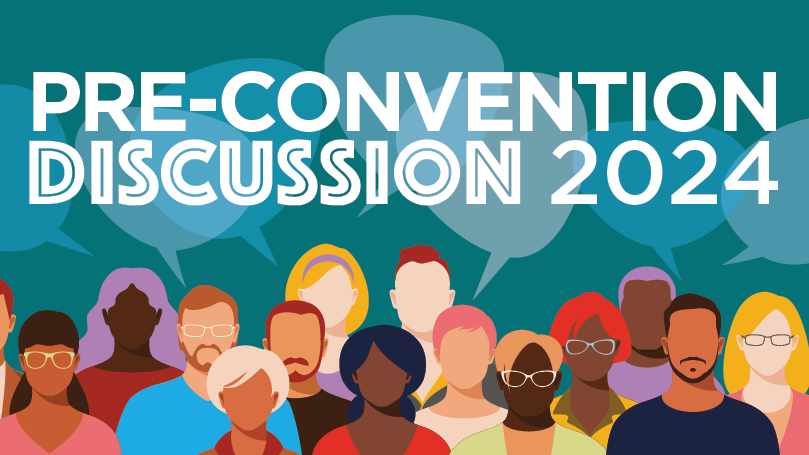
This piece is a contribution to the Pre-Convention Discussion for our 32nd National Convention. During Pre-Convention Discussion, all aspects of the party’s program, strategy, and tactics are up for consideration and debate. The ideas presented here are those of the author or authors alone, and do not necessarily reflect the positions of the Communist Party USA, its membership, or their elected leadership bodies. — Editors
Most retirees are workers. Among progressive movements, organized seniors are top-tier fighters!
Like the women’s movement, gay pride, or other progressive movements, the retiree movement is not 100% composed of workers. Everybody gets old, but the great majority of retirees live primarily from deferred income from their working days in the form of pensions, health care, and Social Security. Social Security is the main source of income for more than half of U.S. seniors.
The retiree movement developed with organized labor
Wikipedia has a history of the development of the U.S. retiree movement since the 1950s. This movement grew out of the push for national health care that had been stymied during the Truman Administration. “Senior Citizens-for-Kennedy,” in the early 1960s, was the root of the present organization. Organized labor formed the National Council of Senior Citizens (NCSC) in order to push for Medicare/Medicaid, and was credited with getting it passed in 1965. The Auto Workers and the Steelworkers, two of the strongest and most progressive unions from the days of the Congress of Industrial Organizations (CIO), were the main strengths of NCSC. Even though NCSC was very active in legislative work and in street demonstrations, no one can overlook the fact that the civil rights movement had a role of equal magnitude because, prior to Medicare/Medicaid, health care was segregated in America. “Power to Heal” is a 1-hour movie about the fight to desegregate health care. Opponents of government-assisted health care, led primarily by the American Medical Association, happily used racism as a way to oppose the new health care legislation. Thankfully, all opponents were overcome.
The lesson that should be learned is that organized labor, united with civil rights movements and engaged in electoral struggle, is a powerful political force for change on behalf of the working class.
Today’s retiree activists
A number of unions organize their retirees. The Autoworkers mandate that every union local have a retiree chapter. Steelworkers set up retiree chapters everywhere they can. Communications Workers, Electricians, Ironworkers, Teamsters, Texas State Workers, and Transport Unions try to keep retirees close to their regular union activities. Since older voters turn out much better than younger ones, retirees are often seen as important activists in union legislative programs. It would be good to say that all the unions join together on retiree issues, but that would be an overstatement. Most of the retirees organized by unions are primarily asked to support the immediate concerns of their own union, not the broader retiree movement that concerns itself with everybody’s pensions, health care, and Social Security.
Many unions never joined the NCSC in its heyday. But the AFL-CIO set out an ambitious program after its progressive turn in 1995. In 2001, the NCSC was converted into the Alliance for Retired Americans (ARA). It is headquartered in the AFL-CIO building in Washington DC, where it keeps track of legislation and lobbies effectively for all retirees. It provides support for organizations nationwide. The ARA is based on unions, but membership is completely unrestricted. Anybody who supports retiree rights, young and old, documented and undocumented, rich and poor, is welcomed. The nominal membership dues fee is $10/year.
Wikipedia says, “As of 2020, the Alliance has 4.4 million members nationwide and has state programs in 39 states. It has 1,500 local chapters.”
Texas Alliance for Retired Americans (TARA) was chartered in 2006. After a slightly confused beginning, it started chapters in all the major metropolitan centers of the state. Each of them meets monthly and engages in every election. They also use every tactic available to carry out campaigns that come from national, from the State AFL-CIO, and some of their own making. At any progressive activity in the state, one is likely to see significant amounts of white hair and bald heads.
Like many organizations in today’s struggles, TARA relies heavily on digital outreach.
Organizing retirees is not exactly the same as organizing other demographics. The reliability of individuals is shaken by sickness and death, Seniors find it difficult to overcome ingrained influences of racism and anti-communism. On the other hand, many of them are veteran fighters in some of the greatest moments in progressive U.S. history, such as the civil rights, civil liberties, and anti-war movements of the 1950-1970 period.
Retirees, especially those organized by the Alliance for Retired Americans, cannot be ignored in building an effective progressive coalition.


 Join Now
Join Now